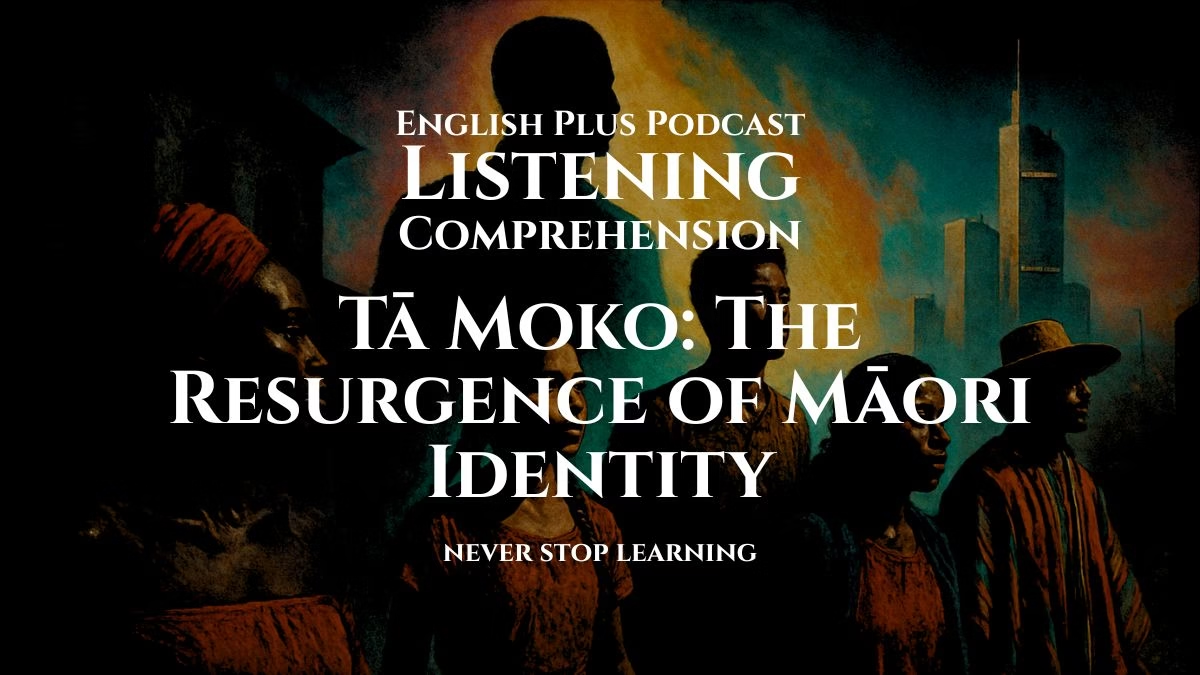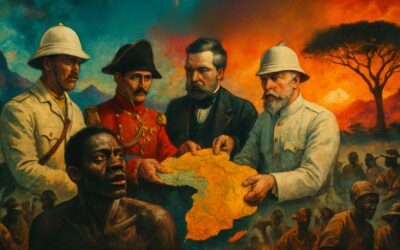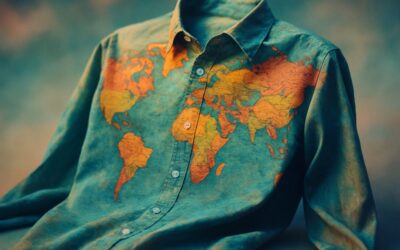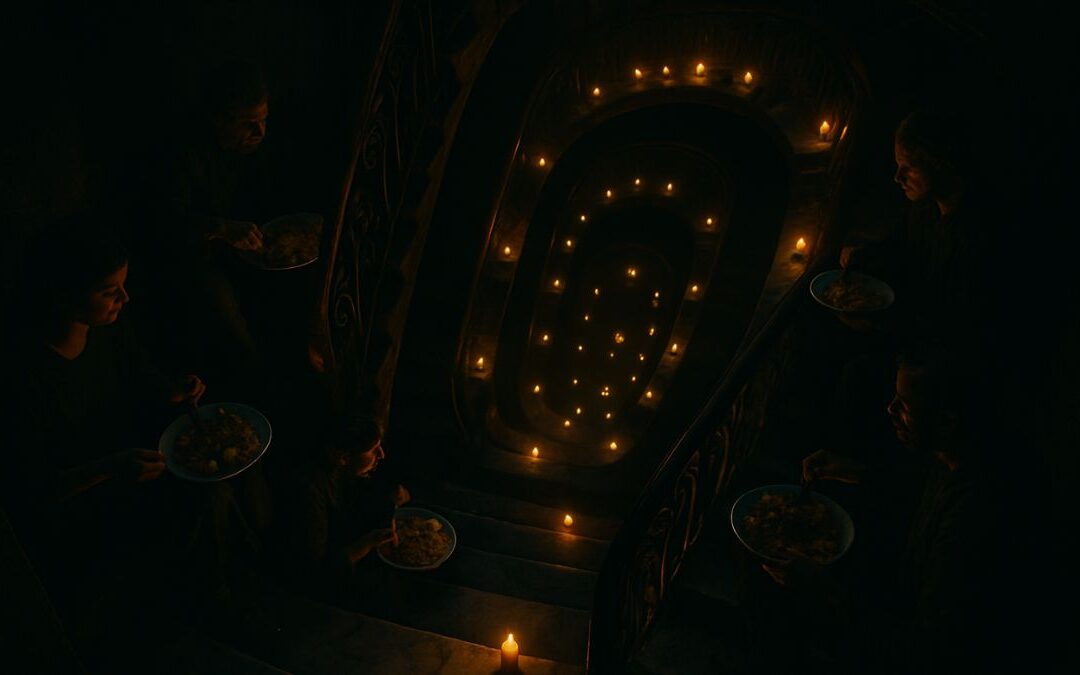Listening Skills for Exam Success
Welcome to this advanced listening practice. The lecture you are about to hear is in a common format for international exams: a single speaker presenting a detailed academic topic. Your goal isn’t just to hear the words, but to understand the structure of the argument.
Here are a few tips for this specific lecture:
- Listen for the Narrative Arc: This lecture tells a story with three distinct parts: the past (what Moko meant), the suppression (what happened to it), and the revival (where it is today). Listen for “signpost” words (like “However,” “Consequently,” “In the 1970s…”) that signal a shift from one part to the next.
- Distinguish Main Ideas from Examples: The speaker will state a main idea (e.g., “Moko is a visual representation of a person’s history”) and then support it with examples (e.g., mentioning specific designs). In your notes, focus on capturing the main idea. The examples are just there to help you understand it.
- Note-Taking is Key: You will not be able to remember 1500 words. Use abbreviations. For this lecture, you might use:
- M = Moko
- W = Whakapapa (genealogy)
- Col = Colonial / Colonization
- $\downarrow$ = Suppression / Decline
- $\uparrow$ = Revival / Resurgence
- ID = Identity
- Infer the Speaker’s Stance: The speaker isn’t just giving facts; they have a point of view. Listen to the adjectives used (“powerful,” “profound,” “resilience”) to understand the speaker’s positive tone toward the revival of Moko.
Topic Introduction
You are about to hear a lecture about Tā Moko, the sacred skin-marking tradition of the Māori, the indigenous people of New Zealand.
Before you listen, think about this: What happens when a core part of a culture’s identity is forbidden by an outside force? And what does it mean for that culture, generations later, to begin taking that symbol back? This lecture explores that exact journey of suppression and resurgence.
Key Vocabulary and Phrases
Here are 12 key terms from the lecture. Understanding them is crucial for understanding the main points.
Indigenous (adj.): Originating or occurring naturally in a particular place; native.
How it’s used: The speaker identifies the Māori as the indigenous people of Aotearoa (New Zealand), meaning they are the original inhabitants.
Whakapapa (n.): (A Māori term) Genealogy; a line of descent. It’s a foundational concept of Māori identity, connecting people to their ancestors, land, and the universe.
How it’s used: The lecture explains that a Moko is not just a pattern; it is a visual representation of a person’s whakapapa, telling the story of their family and tribe.
Resurgence (n.): An increase or revival after a period of little activity, popularity, or occurrence.
How it’s used: This word is central to the lecture’s theme, describing the “powerful modern resurgence” of Tā Moko as a celebrated symbol.
Suppression (n.): The action of forcibly putting an end to something.
How it’s used: The speaker discusses the suppression of Moko during colonization, meaning the active efforts by colonial authorities and missionaries to stop the practice.
Assimilation (n.): The process whereby a minority group gradually adopts the customs and attitudes of the prevailing culture.
How it’s used: The lecture identifies assimilation as the goal of colonial policies—to make the Māori people adopt British culture and abandon their own traditions, like Moko.
Mana (n.): (A Māori term) A foundational concept implying prestige, authority, spiritual power, and influence.
How it’s used: The speaker explains that Moko was traditionally linked to a person’s mana, reflecting their social standing, achievements, and spiritual power.
Tohunga (n.): (A Māori term) An expert practitioner of any skill or art, often in a spiritual or priestly capacity. A tohunga tā moko is a Moko artist.
How it’s used: The lecture points to the “Tohunga Suppression Act” as a key historical event that targeted these cultural experts.
Sacrosanct (adj.): Regarded as too important or valuable to be interfered with; sacred.
How it’s used: The speaker describes the process of receiving Moko as sacrosanct, meaning it is a deeply spiritual and tapu (sacred) ceremony, not just a casual tattoo.
Colonial (adj.): Relating to the policy or practice of acquiring political control over another country, occupying it, and exploiting it.
How it’s used: The lecture frames the entire story within the context of colonial New Zealand, where European (Pākehā) attitudes led to the decline of Moko.
Monolithic (adj.): Consisting of one large, uniform, and indivisible whole; showing no diversity.
How it’s used: The speaker warns against seeing the Moko revival as a monolithic trend, emphasizing that each Moko is unique and deeply personal.
Reclamation (n.): The process of claiming something back or reasserting a right.
How it’s used: The modern revival is described as an act of reclamation—Māori are actively taking back a practice that was taken from them.
Systemic (adj.): Relating to a system, affecting an entire system.
How it’s used: The speaker describes the suppression as systemic, meaning it wasn’t just individual prejudice but was built into the laws and policies of the colonial government.
Listening Audio
Listening Transcript: Please do not read the transcript before you listen and answer the questions.
Today’s lecture focuses on a powerful narrative of cultural loss and recovery. We will be discussing Tā Moko, the sacred facial and body marking of the Māori, the indigenous people of Aotearoa, or New Zealand. For many, the image of the Māori Moko is one of fierce warriors from history books or, more recently, a striking symbol of modern identity. The journey between these two points—from a ubiquitous cultural practice to a symbol of near-extinction, and now to a powerful contemporary resurgence—is what I want to explore.
First, it is essential to understand what Moko is not. It is not, in the Western sense, a “tattoo.” It is not merely decoration. Tā Moko is a sacred, sacrosanct process that uses chisels, or uhi, to carve designs into the skin, creating grooves rather than just implanting ink. More importantly, Moko is an external manifestation of a person’s internal reality. It is a visual encyclopedia of the wearer’s identity.
The patterns of a Moko are not random; they are a deeply personal map. They tell the story of the wearer’s whakapapa—their genealogy. They identify the wearer’s iwi (tribe), their hapū (sub-tribe), and their specific family line. The markings can signify social status, achievements in battle or in the community, and readiness for life’s responsibilities. For men, the full-face Moko is known as Mataora. For women, the traditional Moko is the Moko Kauae, worn on the chin and lips. This Moko Kauae is a profound symbol of womanhood, connecting the wearer to a lineage of Māori female ancestors and their inherent mana, or spiritual power and authority.
Before European contact, Moko was a living, breathing part of Māori society. It was the norm, a rite of passage, a way of carrying one’s history on one’s face.
So, what happened? The answer, as is so often the case in indigenous histories, is colonization.
The arrival of Pākehā—European settlers—in the 19th century began a period of profound and systemic cultural suppression. Colonial authorities and missionaries, viewing the world through their own cultural lens, saw Moko as a “savage” or “barbaric” custom. It was a visible marker of an identity they actively sought to extinguish. The goal was assimilation: to have the Māori people abandon their language, their spirituality, and their cultural practices in favor of a British way of life.
This pressure was immense. Māori who adopted European dress and customs were often given preferential treatment, while those who held to tradition were marginalized. But the suppression was not just social; it was legislative. The most significant blow came in 1907 with the “Tohunga Suppression Act.”
A tohunga is a Māori expert, a master of a specific art or body of knowledge—this includes canoe building, healing, and, of course, Tā Moko. The tohunga tā moko was the artist, the priest, and the historian who held the sacred knowledge of the Moko designs. By banning the practices of tohunga, the colonial government effectively cut the lines of intergenerational knowledge. They didn’t just ban the act of Moko; they outlawed the masters who held the knowledge.
The effect was catastrophic. The practice of Mataora—the full-face Moko for men—died out almost completely. The Moko Kauae for women survived, but only just. For much of the 20th century, Moko Kauae was seen almost exclusively on elderly kuia, or female elders, who were often the last in their line to bear the marking. Moko became a symbol of a “dying” culture, a relic of the past.
But, as we now know, the culture was not dying. It was sleeping.
The turning point was the 1970s. This decade saw the dawn of what is known as the Māori Renaissance. Across the world, indigenous peoples were rising up, demanding civil rights, land rights, and the recognition of their sovereignty. In New Zealand, this movement ignited a new generation of Māori activists, artists, and scholars. They began to ask hard questions about their identity, to challenge the colonial narrative, and to actively reclaim what had been lost.
Language was first. Māori language immersion schools were founded. Land protests, like the famous 1975 Land March led by Whina Cooper, brought Māori rights to the forefront of the national consciousness. And with this came the reclamation of the visual arts.
Tā Moko was reborn. It was a profound, visible, and deeply personal way to state, “I am Māori, and I am proud.”
In the 1980s and 90s, artists began reviving the traditional uhi (chisel) techniques. People began receiving Moko not as a link to the past, but as a commitment to the future—a future where Māori identity would be celebrated, not hidden.
This modern revival, however, is not a simple carbon copy of the past. It is an evolution. While the connection to whakapapa remains paramount, the Moko today also speaks to a modern Māori identity, one that navigates both the traditional Māori world and the modern, globalized one.
What is perhaps most striking about this resurgence is its visibility. For decades, wearing a Moko, especially in a professional setting, was unthinkable. It was seen by the Pākehā-dominated mainstream as “unprofessional,” “intimidating,” or a barrier to employment.
Today, that narrative is being dismantled, led by a generation who wear their Moko with unapologetic pride in every walk of life. You see Moko on university graduates, on lawyers, on doctors, and on teachers. The world took notice in 2019 when Nanaia Mahuta became New Zealand’s Foreign Minister—the first female Member of Parliament in the world with a Moko Kauae. This was not a token gesture; it was a powerful statement that a Māori identity, represented by the Moko, is not a barrier to high office but a source of strength. We see it in the media, with news anchors like Oriini Kaipara, who also wears a Moko Kauae, presenting the primetime news.
This visibility is crucial. It normalizes Moko, challenging and changing colonial standards of beauty and professionalism. It shows young Māori that their heritage has a place of honor, not just in their homes, but in the highest echelons of society.
It is important, however, not to view this revival as a monolithic trend. Each Moko is a unique and deeply personal journey. The decision to receive one is often the result of years of research into one’s family history, of learning one’s language, and of a deep personal commitment to one’s culture.
In conclusion, the story of Tā Moko is a microcosm of the wider Māori story. It is a story of resilience. It shows how a practice can endure systemic suppression, be carried in secret by a faithful few, and then be reborn with new vigor. The Moko today is not a relic; it is a living, breathing testament to the enduring power of identity, a visual declaration that Māori culture is alive, thriving, and shaping the future of Aotearoa.










0 Comments